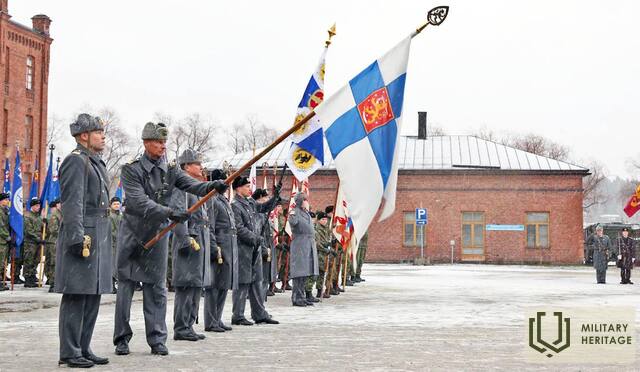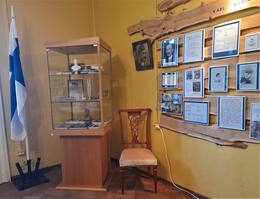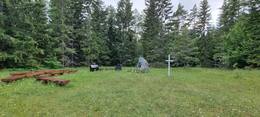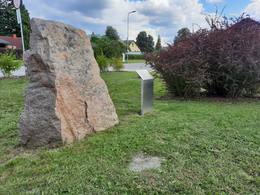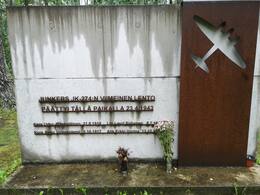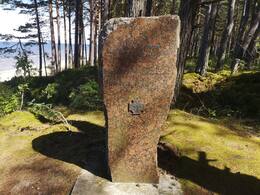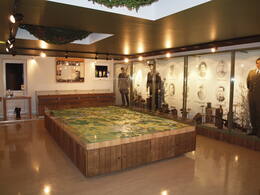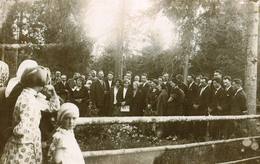Consecration of the Finnish Jaeger flag at Liepāja Holy Trinity Cathedral
The first flag of the Independent Finland was consecrated in 1918 in Liepaja, at the Holy Trinity Church, where the Finnish Jägers took an oath of allegiance to the legitimate government of Independent Finland before going home.
The first flag of the troops of Independent Finland was consecrated on February 13, 1918, in Liepāja, in the Holy Trinity Church. The Finnish jaegers took an oath of allegiance to the legitimate government of Independent Finland.
The following night, the main contingent of the battalion set off for home. They arrived in Vaasa on February 25, 1918.
In Helsinki, the Jaeger flag was first raised on May 16, 1918, at a parade to celebrate the end of the War of Independence. The flag flew in front of the Finnish Jaeger Regiment. The regiment was commanded by the former commander of the battalion's main regiment, Lieutenant Colonel Erik Järnström.
In Finnish Defence Forces parades, the Jäger flag takes pride of place right behind the national flag. Independent Finland remembers its fighters.
https://maavoimat.fi/en/-/jaakareiden-tyo-elaa-puolustusvoimissa
https://jp27.fi/auf-den-spuren-der-jaeger/die-jaegerfahne/?lang=de
Related timeline
Related objects
Memorial plaque to the Finnish Jaegers in the Holy Trinity Cathedral in Liepāja
A memorial plaque dedicated to the Finnish Jaegers is located in Liepāja Holy Trinity Cathedral, Lielā iela 9.
The Finnish Jägers were a unit of the German Empire, formed by volunteers from Finland, which, under the name of the 27th Royal Prussian Jäger Battalion, took part in the First World War battles on the Eastern Front of Latvia in 1916-1917.
During World War I, the Grand Duchy of Finland was part of the Russian Empire and many Finns wanted a German victory in the war in order to promote the establishment of an independent state. On 20 November 1914, the Finnish Independence Movement was founded in Helsinki, which also planned to form the armed forces of an independent state. When the German government confirmed its readiness to train the Finns in January 1915, the recruitment of volunteers began and by the spring of 1916 almost 2,000 soldiers were stationed in Germany and were named the 27th Royal Prussian Jäger Battalion.
From June 1916 the battalion was on the Riga front, when it was moved to Liepaja until March 1917. After the February Revolution, the Russian Empire began to collapse and on 6 December 1917 the Finnish Parliament declared independence.
On 13 February 1918, the Battalion swore allegiance to Finland in the Holy Trinity Church in Liepāja. On 15 February 1918, the battalion left the port of Liepaja by ship to return home to the port of Vasa and take part in the Finnish Civil War against the Reds, who had staged a coup d'état on 27 January 1918. The well-trained and combat-experienced Jägers formed the core of the Finnish national army and a large number became commanders during the Second World War.
The battalion's flag, consecrated in Holy Trinity Church, became the first flag of independent Finland.
Apriki Museum Collections and Red Partisan Activity Areas
The Apriķi manor house houses the Apriķu Museum, whose exhibits tell about the ancient history of the region. The museum exhibits an exposition about the Finnish military figure Karl Gustav Mannerheim - 175 museum items, the interactive stand "KGMannerheim and Apriķi" (in three languages - Latvian, English and Finnish) with 6 sections - about the Apriķi manor, about KGMannerheim as a commander in the Winter War, as the freedom of Finland the leader of the battles and about his connection with the Aprikais.
The museum also displays World War II items with symbols of the German and Red Army, as well as a map - the areas of activity of the Red Partisans) and descriptions of the Red Partisans.
The Baroque ensemble of the Aprikku manor (Apprikken) building was formed by the Alokste River in the 18th century. at first. 20th century in the beginning, the owner of the manor is Carl Gustav Mannerheim, who later became the president of Finland, and is known as the author of the legendary Mannerheim line - the fortification system during the Winter War.
Ingrian Finns Memorial Site in Põllküla
When approaching from Kersalu, before the Põllküla railway crossing, the forest road heads to the right. Along this road, about 200 m away, in a forest clearing, there is a memorial site.
Between 1942 and 1944, over 63,000 Ingrian-Finnish war refugees were evacuated from the Soviet Union to Finland. Most of them were temporarily placed in quarantine and refugee camps located in Põllküla, as well as in Klooga and Paldiski. The evacuees were transferred to Finland via the port of Paldiski.
It is estimated that several tens of thousands of people passed through the Põllküla camp alone. People stayed in the camp for a few weeks to several months. They lived in buildings built for the Red Army in 1939-1940. Living conditions were difficult and they suffered from food shortages, cold, humidity and various infectious diseases. As a result, the mortality rate in the camp was high. It is estimated that about a thousand Ingrian Finns lost their lives in the camp.
The armistice signed on 19 September 1944, which ended the Finnish Continuation War, obliged Finland to extradite Ingrian Finns who were citizens of the Soviet Union to the Soviet Union. In 1944-1945, approximately 56,000 people were repatriated to the Soviet Union.
The Põllküla memorial has a memorial plaque to the dead and to Pentti Kaitera, who led the evacuation.
Memorial stone to the Finnish volunteer regiment "Boys of the North"
Located in Alūksne, at Jāņkalna Street 52, near the Alūksne narrow-gauge railway station.
On February 23, 2019, to mark the centenary of the Latvian War of Independence, at the initiative of the Independence Struggle Traditions Association (Finland), a special memorial site was created to honor the Finnish volunteers who fell for Latvia's independence, where a special boulder and an information plaque testify to the historical events. The memorial stone traveled to Alūksne from Finland - the Salpa Line, which was built in 1940-1944 to protect Finland's Eastern border. The 1,200 km long Salpa Line is one of the most notable defense lines of independent Finland, as well as one of the strongest and best-preserved defense structures of this type in Europe after World War II.
The stone brought to Alūksne symbolizes the struggle of two peoples - the Finns and the Latvians - for their independence. The Finnish volunteer regiment "Boys of the North" went to help the Latvians protect the freedom of the new Latvian state. On February 21, 1919, the "Boys of the North" participated in fierce battles in the vicinity of Alūksne (Marienburg). After a five-hour battle near the Alūksne railway station, the Finns took Alūksne. In this battle, 23 Finnish volunteers lost their lives and many were wounded.
Memorial site for Finnish pilots
Located on the side of the Lilaste-Saulkrasti highway, next to the "Viada" gas station.
The memorial was established in 2013 at the site of a Finnish Air Force plane crash in 1943. Four Finnish army soldiers died in the crash while flying from Germany to Finland. The installation, design and construction of the monument were entirely the initiative of Finnish representatives. It is a tradition of Finnish war pilots to erect memorials at the crash sites of aircraft.
In 1943, Finland purchased 24 modern Junker bombers from Germany. They were intended to supplement the Finnish Army Air Force with modern aircraft. The factory delivered the aircraft in 1943 and, after training the pilots, they were delivered to Finland. The flight of one aircraft ended tragically. Due to technical defects, the pilots were forced to look for a place to make an emergency landing. The aircraft lost altitude, hit trees, crashed into a forest and caught fire. The Finnish pilots were buried in the German army cemetery in Riga during the German occupation of Latvia. They were later reburied in their homeland.
Interestingly, one of the most modern aircraft manufactured in Latvia at the time also crashed in Finland in 1938. It was piloted by Latvian and Finnish army pilots - K. Lešinskis and F. Kuopameki.
Monument in the memory of Finnish jaegers-sappers
Located in Engure municipality, on the side of the A10 highway near the Smārde tavern.
The memorial is located in the field opposite the Smårde pub, where the Battle of Smårde took place in 1916 during World War I. A Finnish Jaeger engineer company (~200 men) participated in the fighting as part of the German army. "Smårde Day" has become the official holiday of the military engineers of the Finnish army, which is still celebrated today.
The Finnish Jaegers were a unit of the German Army formed during World War I. They consisted mainly of nationally minded Finnish volunteers from the Russian Empire and Finland. The Battle of Smårde was one of the most significant offensive battles of the Finnish Jaegers, where new tactics were used at the time.
A month after this event, the Russian army attacked the German army near Smārde. Latvian combat units conducted reconnaissance of the Smārde area, built a supply road “Latvian Road” across the swamp, and participated in the fighting. About 300 Latvian fighters fell in the battles. Like the Finnish jaegers in the German army, the Latvian riflemen in the Russian army were the founders of their own national states and armies.
Museum-room of the Finnish Boys
This museum room is situated in Saadjärve Nature Centre in the small borough of Äksi.
It was opened in 2002 on behalf and with the support of the Finnish Boys Association, Tartu Municipal Government and the Finnish state.
It provides an overview of the battles in Finland and Estonia in which the Finnish Boys participated during World War II. Here you will see a scale model depicting the battles fought in Jõgeva and Tartu counties and the uniforms, equipment, armaments, military decorations, personal belongings and photos of the Finnish Boys. The bunker is also open to visitors.
Free admission.






